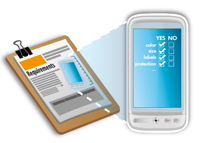 Some importers send information about the product they expect through many different channels:
Some importers send information about the product they expect through many different channels:
- Email threads;
- Skype or QQ conversations;
- In the form of samples, or validations of counter-samples;
- Drawings and explanations in face-to-face meetings.
And they expect the supplier’s salesperson to gather all this information, translate it, and present it in a unified and coherent manner to the engineers and technicians who will manage production!!
In my view, it is the importer’s responsibility to gather all product specifications in one master document, and to keep it updated.
The difficulty, of course, is to find a template that makes sense. Well, you are in luck. Here is a template that I think is pretty good:
Feel free to download this Product Specification Template and to modify it if needed.
(Right-click on the link and select “save target as…”)
If you want to get closer to best practices, I have some more advice:
- Think of the QC inspection and testing process when writing this document. It means you will include tolerances, descriptions of potential defects, and so on. (More info on this topic in How to prepare a QC inspection checklist).
- Get this document reviewed by a quality assurance agency, if you want feedback to make it more precise and more useful.
- Have someone translate it if you don’t fully trust the supplier’s salesperson to do so (a simple rule of thumb is that, if she doesn’t want to show you the translated document, it was never translated in the first place).
- Get a factory manager to comment on it, and adapt it if necessary. Two-way communication is very important.
- Ask the supplier to date, sign, and stamp it to indicate their acceptance of your specifications.
—
If this article was helpful to you, feel free to share it by using the social options below. Thanks!

Hi Renaud,
I discovered your blog just a few days ago, I want to thank you for giving so much clarity to the issue of quality control and supplier managing in China. That’s specially important for new small importers who often can’t afford to make many mistakes, if any.
Regarding this post, I would just like to say that when I click on the “specification sheet template” link, a new window with the url https://www.qualityinspection.org/wp-content/uploads/2013/07/Spec-sheet-template.docx, comes up, but the original contents is missing, I mean, there are only letters, numbers and special symbols, which all together don’t make much sense.
Thanks for the nice comments!
If you have trouble downloading the template on this page, maybe you will have more luck at https://www.globalsources.com/NEWS/How-to-define-quality-standard-buying-from-China.HTM.
Hi Renaud,
yes it works, thanks. Also I discovered why I couldn’t open the link on the post: a “save as” using the mouse left button should be done, instead of just clicking on it.
David FG
Great. Sorry about that. Actually it depends on the browser.